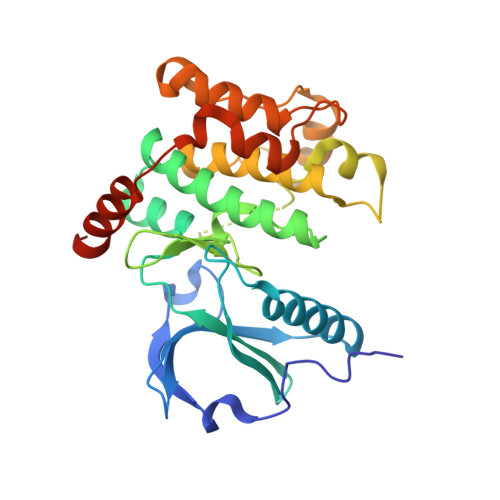Comprehensive Characterization of the Published Kinase Inhibitor Set.
Elkins, J.M., Fedele, V., Szklarz, M., Abdul Azeez, K.R., Salah, E., Mikolajczyk, J., Romanov, S., Sepetov, N., Huang, X.P., Roth, B.L., Al Haj Zen, A., Fourches, D., Muratov, E., Tropsha, A., Morris, J., Teicher, B.A., Kunkel, M., Polley, E., Lackey, K.E., Atkinson, F.L., Overington, J.P., Bamborough, P., Moller, S., Price, D.J., Willson, T.M., Drewry, D.H., Knapp, S., Zuercher, W.J.(2016) Nat Biotechnol 34: 95
- PubMed: 26501955
- DOI: https://doi.org/10.1038/nbt.3374
- Primary Citation of Related Structures:
4USD, 4USE, 4USF - PubMed Abstract:
Despite the success of protein kinase inhibitors as approved therapeutics, drug discovery has focused on a small subset of kinase targets. Here we provide a thorough characterization of the Published Kinase Inhibitor Set (PKIS), a set of 367 small-molecule ATP-competitive kinase inhibitors that was recently made freely available with the aim of expanding research in this field and as an experiment in open-source target validation. We screen the set in activity assays with 224 recombinant kinases and 24 G protein-coupled receptors and in cellular assays of cancer cell proliferation and angiogenesis. We identify chemical starting points for designing new chemical probes of orphan kinases and illustrate the utility of these leads by developing a selective inhibitor for the previously untargeted kinases LOK and SLK. Our cellular screens reveal compounds that modulate cancer cell growth and angiogenesis in vitro. These reagents and associated data illustrate an efficient way forward to increasing understanding of the historically untargeted kinome.
Organizational Affiliation:
Structural Genomics Consortium and Target Discovery Institute, Nuffield Department of Clinical Medicine, Old Road Campus, University of Oxford, Oxford, UK.















